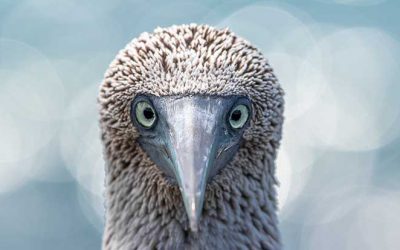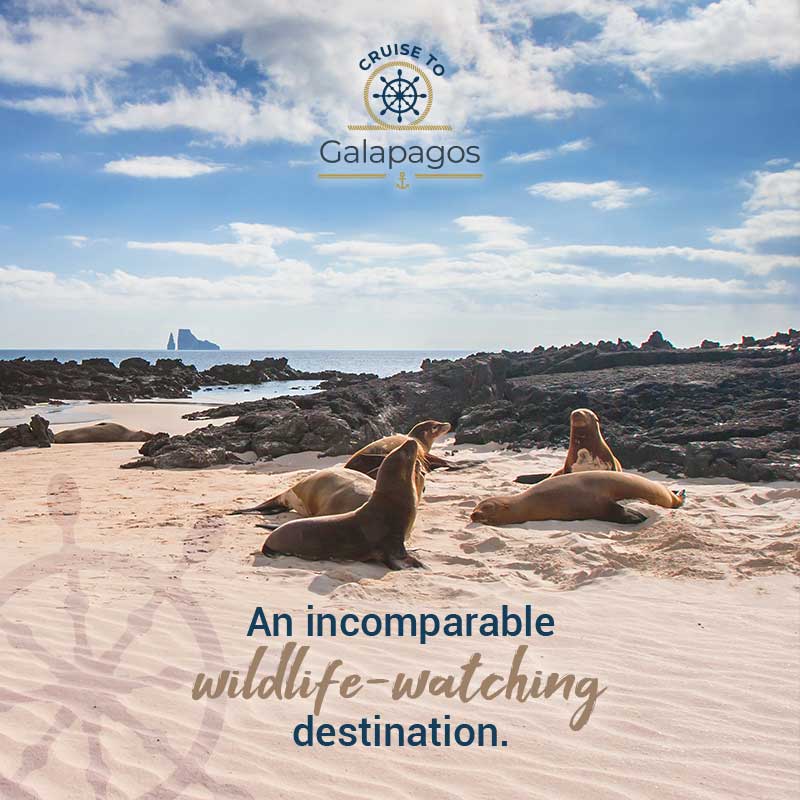Galapagos Islands, the natural laboratory of the world
Stay up to date with our most recent news and updates
Of volcanic origin, its natural history still amazes the world. The Galapagos Islands are known as a natural laboratory of evolution. The age of the islands, the geographical isolation, and the marine currents that bathe the archipelago have contributed to the evolution of new species of flora and fauna unique in the world. Almost two hundred years after the theory “The evolution of species“, animals like Darwin’s finches continue evolving.
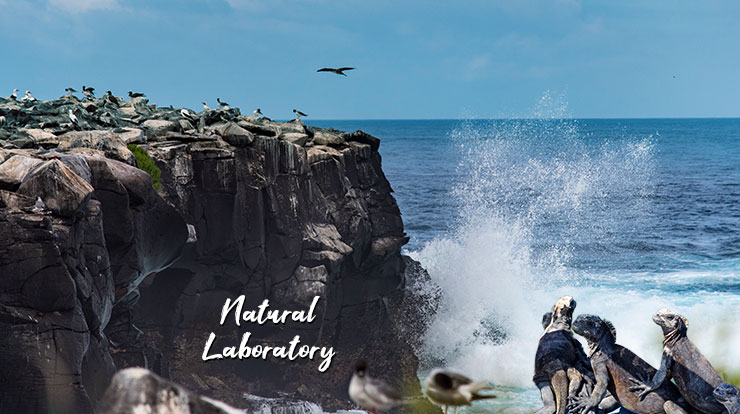
Galapagos natural-laboratory
It is an honor for anyone to live an incomparable experience in this living laboratory that continues to captivate global science. 234 islands, islets, and rocks of volcanic origin form this mythical archipelago, which is home to 7,145 species. Their endemism, that is, the number of unique species in the world, covers 32% of the Islands.
The Origin of the Galapagos Islands
The Galapagos Islands emerged from the ocean 4 to 5 million years ago, as a result of underwater volcanic action. In geological terms, the islands are very young. As these new islands cooled, two million years later, certain species gradually arrived from Central and South America.
These first immigrants quickly had to adapt to a new and peculiar environment. Later evolved into species different from those of its continental ancestors. Therefore new unique species emerged in the world.
Even now volcanic activity has been detected in some Islands. This show is truly amazing. Those who have the privilege of witnessing it from afar onboard a cruise can see a landscape of fireworks that intertwine with the magnificence of nature.
The most recent volcanic spectacle occurred this year 2020, on January 13rd at the La Cumbre volcano, on Fernandina Island (an uninhabited island). One of the youngest Galapagos Islands. The lava flow could be observed descending towards the coast.
Charles Darwin’s theory of evolution
Years later, after the geological and wild evolutionary process of the Galapagos Islands. The famous archipelago made its triumphal entry into the world of science with Charles Darwin’s theory of evolution.
In 1835 the young scientist arrived in the Galapagos Islands on the Beagle boat. The territory mostly frequented by pirates and whalers was key to the development of Darwin’s theory. Who only in 5 weeks of stay wrote his first theory about evolution. “The archipelago is unique. The islands are a living laboratory for animal species that do not exist anywhere else on the planet (…). We are facing the biggest mystery, which is the appearance of new beings on Earth ”.

Charles Darwin
His enthusiasm turned into an investigative passion. He became obsessed with his observations on the different shapes and sizes of beaks of the finches, the diversity between the shells of the turtles, or the variations in the color of the skin of the iguanas.
Species like these are iconic and unique to the Galapagos Islands but especially the giant tortoises, unique to the archipelago that do not exist anywhere else in the world.
The name of the island comes from the Galapagos giant tortoises. The story tells that Spanish explorers called the turtles “galapago” (saddle) because of their large carapace that resembled a saddle.
The Origin of Species

Galapagos Finches
These singularities established the characteristics of the beings that inhabit it. Darwin called this behavior “natural selection”. Subsequently, other revolutionary conclusions were published in The Origin of Species, in 1859. Theory worldwide known, that changed the course of modern science.
Natural Awards
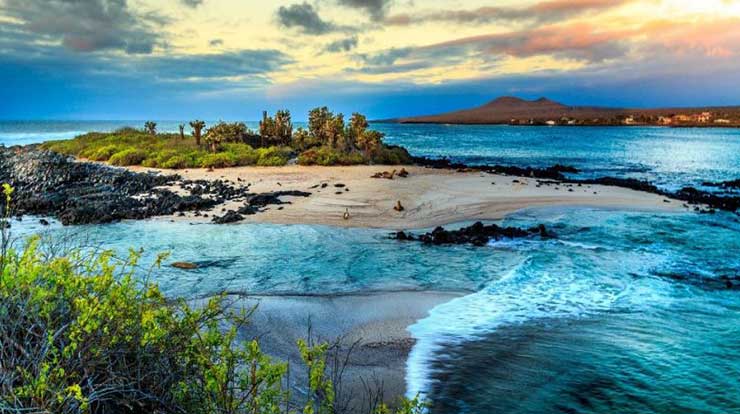
Galapagos National Park
Today, much of the wildlife that Darwin studied continues to thrive in this archipelago. Where 97 percent of its extension was declared a National Park. In 1979 was declared World Heritage Site. Since 1985 have owned the title of Biosphere Reserve.
Galapagos animals are special because they are not afraid of man
The trails around the Islands are full of wonderful and unique species. A great variety of sea and land turtles, penguins, iguanas, frigate colonies, albatrosses, endemic species of finches, or the only cormorants in the world that, due to evolution, have lost the ability to fly. You can enjoy the presence of these and other animals that migrate to this paradisiacal island.
It is not surprising that during the journey we come across a few meters with the incomparable blue-footed boobies. Or even during the activities, we can swim with dolphins, sea lions, and an infinity of multicolored fish. The Islands really seem to be encapsulated in a magical tale.

Meek Animals
Galapagos is the only place in the world where you can live this close experience with nature just 6 feet away in the middle of the entire ecosystem of the most amazing and wonderful species in the world. In fact, this is its main attraction and what has led it to be awarded as one of the top destinations around the world. Compared to other famous natural destinations such as Africa and Antarctica, wild animals can also be observed but from afar and with the help of binoculars.
The Galapagos Islands are full of never-seen species that have absolutely no fear of approaching humans because it is the only place in the world where there are no predators. Even humans because due to the strict rules of the National Park, all actions converge to preserve and care for the Galapagos species.
Galapagos is the truly natural laboratory of the world for these main reasons
- Great studies and discoveries for its great diversity of underwater wildlife.
- Their geological interest: various geological and geomorphological processes take place on the islands such as volcanic eruptions, seismic movements, and erosion, which makes them an ideal environment for scientific study.
- The great interest that arouses the origin and evolution of its flora and fauna, the theory of the famous Charles Darwin.
- Animal wealth. Although the islands are young, they are home to species as emblematic as giant tortoises and many other endemic and protected species such as the world’s only marine iguana.
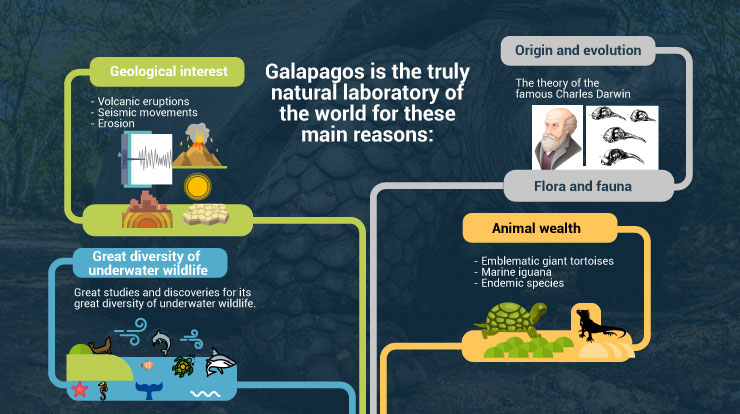
Galapagos living laboratory
RELATED POST
Traveling to the Galapagos Islands in 2022: tips, what to do, and how to book the best trip ever
Learn more about the Galapagos Islands and how to make the most of your trip to this natural destination with this quick guide.
Blue-footed Booby Interesting Facts
The blue-footed boobies of the Galapagos Islands, as beautiful as they are unique. Discover here some interesting facts about them.


